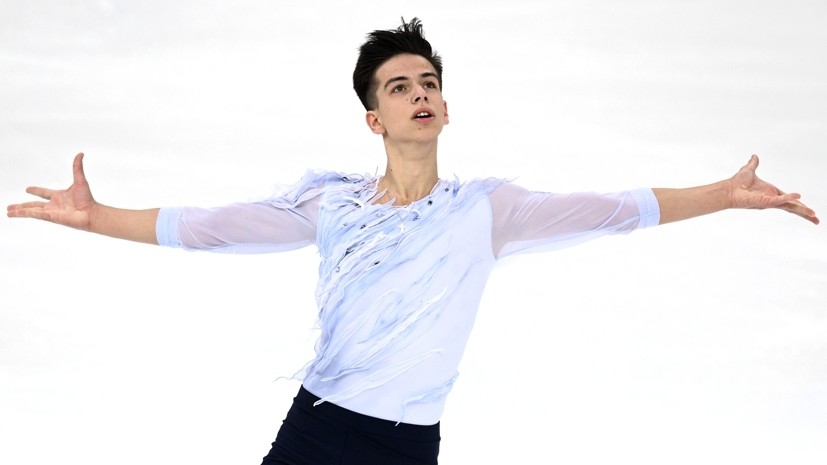The men's singles tournament became, as expected, an opportunity to see all quadruple jumps, except for the axel and flip: the second of them was listed in Andrey Anisimov's pre-start application, but the skater opened up after three revolutions during his performance.
Before the start of the competition, it was still thought that such a variety would take place rather in a free program than in a short one, but the guys immediately went for broke.
Alexander Samarin jumped lutz, Pyotr Gumennik and Makar Ignatov - rittberger, the rest - sheepskin coat and salchow.
In total, eight of the seventeen athletes who entered the tournament included two jumps in four turns in their short programs, and this was a significant event: with such content, Russian single skaters would not be ashamed to come to any international tournament, including the most significant ones.
The escalation of difficulty in figure skating has always been in waves.
In order to, in the language of computer games, move to the next level, you need not only talent and a competent coach, but also a reference point.
Therefore, in fact, at all times it was considered an outstanding achievement to perform a complex element first in the world.
Alexandra Trusova became such a pioneer in women's skating.
In men, everything turned out to be more complicated.
Could, for example, the champions of the Games in Salt Lake City and Turin, Alexei Yagudin and Evgeni Plushenko, raise the bar for jumping difficulty 20 years ago?
In terms of talent and physical condition, probably yes.
But Yagudin (he was the first to perform two quadruple sheepskin coats in the finals of the Olympics) ended his career a year after the triumph for health reasons.
Plushenko, with a similar arsenal to Yagudin's, it was simply not necessary, although Evgeny learned the quadruple lutz back in the very beginning of the 2000s, and six months before Salt Lake, his coach Alexei Mishin assured journalists that the problem of this jump to the Olympics would be resolved.
Alas, intentions remained intentions.
Well, then, after the departure of the main rival, it seemed like there was no need for Evgeny to take an increased risk.
The quadruple sheepskin coat and the “four plus three” cascade was enough for the skater to effortlessly beat anyone.
The starting point of a breakthrough seems to be Maxim Kovtun and his five quads in two programs in 2014.
But with a caveat: the ward of Elena Buyanova jumped all the same sheepskin coats and salchows, that is, the simplest ones.
Trying to remember what served as a trigger in mastering the “senior”, that is, more complex quads, I approached Evgeny Rukavitsyn, whose student Makar Ignatov was remembered for successful attempts at the most “shaky” of the jumps - the rittberger.
But the coach also found it difficult to answer.
Moreover, he said that he was not at all sure that the storming of difficult quads by skaters could be considered massive.
“There has to be a middle ground between risk and performance reliability, as GOE judges now sometimes decide more than risk and difficulty.
On the quality of the elements, you can score much more points, although more and more athletes begin to complicate the programs as much as possible.
Adults and already accomplished athletes have a kind of golden parachute in the form of a second assessment.
Therefore, those who compete with them have no other option but to take risks, ”the coach explained.
The grandmaster's hundred was surpassed in the short program only by Gumennik.
The skating with quad loops and salchow was so successful for him that the coach Veronika Daineko, at the sight of the marks, could not hold back her tears.
The 20-year-old skater became one of the leaders during the Russian Grand Prix, where he performed four quads, including a rittberger and a lutz in a free program.
That is, jumps that are considered the most difficult to perform after the Axel.
With Lutz, everything is clear: it has the highest base cost - 11.50.
What is the complexity of the rittberger, Rukavitsyn explained.
He noted that this jump in the quadruple version requires from the skater not so much physical condition as a strong nervous system.
“In order to maintain the correct entrance arc, composure is required: on the one hand, it is necessary to carry it out as if “backhand”, on the other hand, very careful control is needed.
And this combination of control with maximum amplitude is at the forefront in the loop, ”the specialist clarified.
For the maximum possible complexity, Gumennik had to learn flip and axel.
About the intention to show the world the latter, which so far only the American Ilya Malinin owns, and even then not perfectly, Peter spoke back in the summer.
In other words, he considers the goal quite achievable.
Formally, there are no obstacles to this.
Veronika Daineko began her coaching career as an assistant to Alexei Mishin at his school, so she knows jumping equipment thoroughly.
In addition, Gumennik maintains contact with Rafael Arutyunyan, a specialist who trained the last of the Olympic champions, Nathan Chen, and also advised Malinin.
It is interesting that at some stage of his career, Peter's jumps did not go at all, and the same Arutyunyan believed that the problem was in the skater's specific physique.
But now Peter has a chance to become the first in Russia to present all six quads at competitions.

